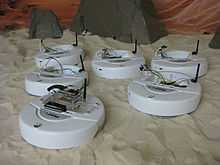Swarm robotics


Swarm robotics is a new approach to the coordination of multirobot systems which consist of large numbers of mostly simple physical robots. It is supposed that a desired collective behavior emerges from the interactions between the robots and interactions of robots with the environment. This approach emerged on the field of artificial swarm intelligence, as well as the biological studies of insects, ants and other fields in nature, where swarm behaviour occurs.
Definition
The research of swarm robotics is to study the design of robots, their physical body and their controlling behaviors. It is inspired but not limited by the emergent behavior observed in social insects, called swarm intelligence. Relatively simple individual rules can produce a large set of complex swarm behaviors. A key-component is the communication between the members of the group that build a system of constant feedback. The swarm behavior involves constant change of individuals in cooperation with others, as well as the behavior of the whole group.
Unlike distributed robotic systems in general, swarm robotics emphasizes a large number of robots, and promotes scalability, for instance by using only local communication. That local communication for example can be achieved by wireless transmission systems, like radio frequency or infrared.
Goals and applications
Both miniaturization and cost are key-factors in swarm robotics. These are the constraints in building large groups of robotics; therefore the simplicity of the individual team member should be emphasized. This should motivate a swarm-intelligent approach to achieve meaningful behavior at swarm-level, instead of the individual level.
Simple Swarmbots
A lot of research has been put into achieving this goal of simplicity at the individual robot level. Being able to use actual hardware in research of Swarm Robotics in place of simulations allows researchers to come across and resolve a lot more issues and thus, broadens the scope of Swarm Research greatly. Thus, development of simple robots for Swarm intelligence research is a very important aspect of the field. The goals of these projects is manifold, including but not limited to keeping the cost of individual robots low in order to be able to make the swarms scale-able, making each member of the swarm less demanding in terms of resources and making them more power/energy efficient. One such system of swarm is the LIBOT Robotic System[1] that involves a low cost robot built for outdoor swarm robotics. The robots are also made to have enough provisions for indoor use via Wi-Fi, since the GPS sensors provide poor communication inside buildings. Another example of such an attempt is the micro robot (Colias),[2] built in the Computer Intelligence Lab at the University of Lincoln, UK. This micro robot is built on a 4 cm circular chassis and is low-cost and open platform for use in a variety of Swarm Robotics applications.
Applications
Potential applications for swarm robotics is indeed huge. It includes tasks that demand for miniaturization (nanorobotics, microbotics), like distributed sensing tasks in micromachinery or the human body. One of the most promising uses of swarm robotics is in disaster rescue missions. Swarms of robots of different sizes could be sent to places rescue workers can't reach safely to detect the presence of life via infra-red sensors. On the other hand swarm robotics can be suited to tasks that demand cheap designs, for instance mining tasks or agricultural foraging tasks. Also some artists use swarm robotic techniques to realize new forms of interactive art.
Much more controversial than the above-mentioned uses of Swarms, they can also be used in military to form an autonomous army of their own. Recently, the U.S. Naval forces have tested a swarm of autonomous boats that [3] can steer and take offensive action by itself. The boats are unmanned and can be fitted with any kind of kit to deter and destroy enemy vessels.
Most efforts have focused on relatively small groups of machines. However, a swarm consisting of 1,024 individual robots was demonstrated by Harvard in 2014, the largest to date.[4]
See also
- Kilobot
- Ant robotics
- Behavior-based robotics
- Flocking (behavior)
- Nanorobotics
- Nanomorph
- Microbot
- Multi-agent systems
- Swarm intelligence
- Autonomous agents
- Physicomimetics
- List of emerging technologies
External links
- iWARD stands for Intelligent Robot Swarm for Attendance, Recognition, Cleaning and Delivery and funded by FP6
- Swarm-bots: Swarms of self-assembling artifacts -- EU IST-FET project (2001-2005)
- Award-winning swarm-bot video at AAAI 2007
- i-Swarm project -- EU IST-FET project (2004-2008)
- Swarmanoid: Towards Humanoid Robotic Swarms -- EU IST-FET project (2006-2010)
- Award-winning swarmanoid video at AAAI 2011
- The Kilobot project
- Epuck robots
- Award-winning video on collective decisions in robots at AAAI 2015
References
- ↑ Zahugi, E.M.H.; Shabani, A.M.; Prasad, T.V., "Libot: Design of a low cost mobile robot for outdoor swarm robotics," Cyber Technology in Automation, Control, and Intelligent Systems (CYBER), 2012 IEEE International Conference on , vol., no., pp.342,347, 27–31 May 2012 doi: 10.1109/CYBER.2012.6392577
- ↑ Arvin, F.; Murray, J.C.; Licheng Shi; Chun Zhang; Shigang Yue, "Development of an autonomous micro robot for swarm robotics," Mechatronics and Automation (ICMA), 2014 IEEE International Conference on , vol., no., pp.635,640, 3-6 Aug. 2014 doi: 10.1109/ICMA.2014.6885771
- ↑ http://www.cnn.com/2014/10/06/tech/innovation/navy-swarm-boats/
- ↑ "A self-organizing thousand-robot swarm". Harvard. 14 August 2014. Retrieved 16 August 2014.
| |||||||||||||||||||||||||||||||||
| ||||||||||||||||||||||||||||||||||||||||||||||||||||||||||||||||||||||||||||||||||||||||||||||||||||||||||||||||||||

